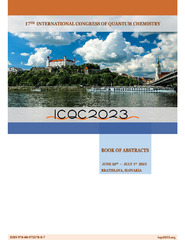Приказ основних података о документу
Antiparallel interactions as a mode of hydrogen bonding: Case of water in solid state
| dc.creator | Zarić, Snežana D. | |
| dc.creator | Milovanović, Milan R. | |
| dc.creator | Stanković, Ivana M. | |
| dc.creator | Živković, Jelena M. | |
| dc.creator | Ninković, Dragan B. | |
| dc.creator | Hall, Michael B. | |
| dc.date.accessioned | 2023-12-08T13:21:17Z | |
| dc.date.available | 2023-12-07 | |
| dc.date.issued | 2023 | |
| dc.identifier.isbn | 978-80-973578-8-7 | |
| dc.identifier.uri | http://cherry.chem.bg.ac.rs/handle/123456789/6372 | |
| dc.description.abstract | Water is one of the most important molecules; it is clear that life on Earth depends on its anomalous properties derived from its unique structure: small size and high polarity [1] as well as flexibility [2]. A fundamental ability of water is hydrogen bonding. Hydrogen bonds are generally considered strong when the H···Y distance is 2.2 to 2.5 Å and the X—H···Y angle is 170 to 180⁰, whereas for weak hydrogen-bond interactions, the H···Y distance is larger than 3.2 Å and the bond angle is less than 130⁰. Between strong and weak interactions are those ones of the moderate strength [3]. In this work [4], we analyzed geometries of all water–water interactions in the Cambridge Structural Database (CSD). We found 9928 water-water contacts and for all of them we calculated interaction energies at the accurate CCSD(T)/CBS level. Our results indicate two types of attractive water–water interactions; the first type involves the classical hydrogen bonds (dOH < 3.0 Å and α > 120⁰), whereas the second type involves antiparallel O—H bond interactions (Figure 1). Namely, c.a. 70% of attractive water–water contacts are classical hydrogen bonds with most being stronger than -3.3 kcal/mol, while c.a. 19% of attractive water–water contacts are antiparallel dipolar interactions with interaction energies up to -4.7 kcal/mol. | sr |
| dc.language.iso | en | sr |
| dc.relation | info:eu-repo/grantAgreement/MESTD/inst-2020/200168/RS// | sr |
| dc.relation | info:eu-repo/grantAgreement/MESTD/inst-2020/200288/RS// | sr |
| dc.rights | openAccess | sr |
| dc.rights.uri | https://creativecommons.org/licenses/by/4.0/ | |
| dc.source | 17th International Congress of Quantum Chemistry (17thICQC), Book of abstracts, June 26 – July 1 2023, Bratislava, Slovakia | sr |
| dc.title | Antiparallel interactions as a mode of hydrogen bonding: Case of water in solid state | sr |
| dc.type | conferenceObject | sr |
| dc.rights.license | BY | sr |
| dc.type.version | publishedVersion | sr |
| dc.identifier.fulltext | http://cherry.chem.bg.ac.rs/bitstream/id/34480/bitstream_34480.pdf | |
| dc.identifier.rcub | https://hdl.handle.net/21.15107/rcub_cherry_6372 |


